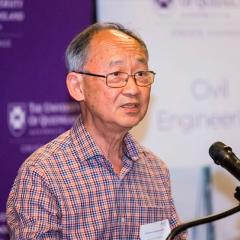Australia’s architectural landscape has been missing a socially critical layer: the acknowledgement of a history of Indigenous architecture and landscape cultural histories. This recognition is vital to the cultural needs of Australia’s Indigenous people.
Across the country, housing and community institutions like hospitals, clinics and courthouses have been designed to cater for the functional and aesthetic needs of Anglo-Celtic Australians, but fail to meet the cultural needs of Aboriginal and Torres Strait Islander communities.
Change has been decades in the making, with UQ researchers leading the way. In 1976, UQ established the Aboriginal Data Archive to focus on cultural safety in built environments – the first time research about Aboriginal architecture had been carried out in Australia.
Since then, the unit has grown to become the Aboriginal Environments Research Centre (AERC) – a research and teaching centre based in UQ’s School of Architecture that focuses on increasing awareness of culturally appropriate architecture for Australia’s Indigenous peoples.
Over the past 40 years, AERC researchers have worked tirelessly to change the way the architecture profession and government agencies think about culturally appropriate design, which has led to positive changes that are improving the lives of many Indigenous Australian communities.
Professor Paul Memmott has dedicated the majority of his career to this research, and it was his book Gunyah, Goondie and Wurley: The Aboriginal Architecture of Australia, in 2007, that first brought the term ‘Aboriginal Architecture’ to the profession’s attention.
Professor Memmott says there needs to be an acknowledgement of catering to different cultures through architecture.
“If we look at traditional Indigenous communities, we start to see there are different behavioural styles when it comes to cooking, sleeping, preparing food, washing and socialising,” he says.
“When we look at how people do those things, they can be done in characteristically different ways which can depend on how many people there are, the size of the household, how people divide into sleeping spaces, or what roles people have in the household.
“We also have to remember that all over Australia, Aboriginal cultures vary from region to region, so what might suit somebody in Inala or West End might be quite different to what would suit somebody in Alice Springs.
“It’s important to develop a built environment that caters to those cultural differences. They’re really basic things and it might be equally as different for a Vietnamese family or an Indian family.”
Professor Memmott says the profession’s growing understanding of the term is significantly contributing to Indigenous communities attaining their rightful place in the architectural and social history of the nation.
Influencing Policy
UQ's research into how Indigenous people use and procure housing, and the administrative barriers they experience, has also had significant influence on policy development and change.
For example, Queensland Government departments have relied heavily on AERC research to provide context and information about how to better provide services to solve Indigenous overcrowding and homelessness.
Professor Memmott says this is just one of the many ways AERC researchers are working with Indigenous communities to contribute to positive change by redressing problems that have plagued their communities.
“We have longstanding Aboriginal community clients who are collaborators with our research group” Professor Memmott explains.
“You’ll start on a design issue and then a client group will take you on an ongoing journey once there is a relationship of trust, and will ask you to assist with other problems that they’re experiencing. This is how we get involved in helping them to address issues like homelessness, crowding, family violence and social issues.”
Research into community consultation and healthcare settings by one of the AERC’s Adjunct Associate Professors Shaneen Fantin recently resulted in the development of a culturally sensitive health facility for Indigenous people in Cairns with an acquired brain injury, known as the Synapse Warner Street accommodation for people with complex disability – an Australian first.
Design practices People-Oriented Design (POD) and Indij Design, both directed by graduates of UQ's School of Architecture, took a collaborative and intercultural approach to this project, working between the client, design team and traditional owners.
Based on this community consultation, the facility’s design included floor plans that suit Indigenous cultural norms of family visitation, taking into consideration room shape and scheme layout. The building’s design also featured seasonal native planting to stimulate residents’ senses, and had views to significant local story places.
More work to be done
While the AERC has made great progress over the past 40 years in raising awareness of the importance of culture in the built environment, Professor Memmott says there is “still a long way to go”.
“The housing situation for Aboriginal people across many parts of Australia is still atrocious, and there is still extreme crowding, which exacerbates social and health problems”
“There’s a lot more work to be done, views to be changed, and knowledge to be put into the public arena.”
Visit the Aboriginal Environments Research Centre website to learn more about how the team is working to advance research on Indigenous cultures and environments.



